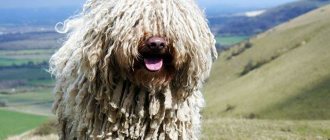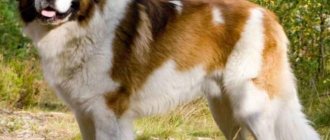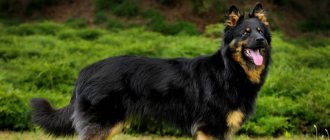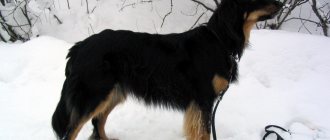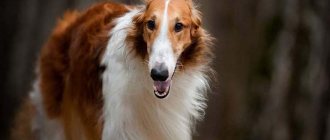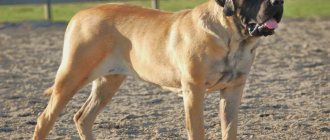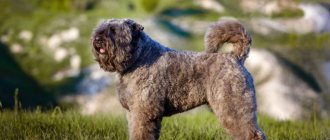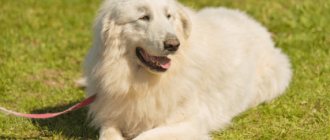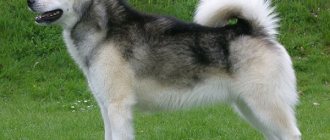A guide dog is an indispensable companion for a person with visual impairments. However, not every breed will be suitable. When selecting applicants, the coach must pay attention to such character traits as:
- easy learning;
- ability to concentrate;
- patience;
- excerpt;
- mental stability;
- friendliness.
Aggression and security qualities are unacceptable for guide dogs. Otherwise, they will pose a threat not only to others, but also to the owner himself. Guides can only warn about danger. Following a given route just half a length ahead, they take into account not only the permitted places for crossing the road, holes and curbs, but also pay attention to branches and low-lying electrical wires. In a word, such a companion for a blind person is simply irreplaceable.
Every dog is subject to education and training, but during long training only a select few remain. Some breeds have gained the greatest popularity due to character traits inherent in nature. However, you have to choose not only based on personal preferences: the dog must be of suitable height so that it is easy for a person to hold the harness. Let us next consider the most popular breeds, proceeding from the tallest to the shorter brothers.
German dog
This is a noble, large dog, which, due to its height (80-90 cm at the withers), is more suitable for adults than for children. They are proud and proud, however, these qualities do not prevent them from faithfully and loyally serving their owner and helping him even in difficult situations. The Great Dane is an easily controlled and trainable, obedient dog. They do not pay attention to external provocations and remain calm and self-controlled, however, they treat suspicious strangers with distrust, protecting the person.
They are not always easy to train: commands are learned slowly compared to other breeds, but if the pet remembers it, then it is forever. It will take 3-4 times to remember the route. A special mindset and sense of responsibility allows you to process a large flow of information, analyze it and make an informed decision. You can undoubtedly trust this dog with your life. Having completed the main tasks, they prefer to relax near the owner, enveloping him with their love and warmth.
How to accustom an animal to one owner
After the dog begins to work properly, it is necessary to make it clear who its true owner will be. No matter how many trainers the pet has, it must obey exclusively the person it will accompany.
Thus, after the dog has learned to correctly carry out all the necessary commands and maneuvers, he must be introduced to his ward. It is very important that the dog masters the exact route used by a blind person. This will help the pet feel at ease when it needs to fulfill its intended purpose.
It is very important to note that it is the behavior of the new owner that plays a key role in their relationship with the dog. Therefore, a person should devote as much time as possible to the dog and try to make friends with him. Only if there is complete trust and mutual understanding will the dog try to do everything as best as possible.
However, during the training process, the instructor may make mistakes that do not have the best impact on the dog’s relationship and performance of direct duties. Most of these negative aspects are as follows:
- the trainer allows himself to be rude to the dog;
- aggression towards people or other pets is approved;
- speed training. Such an irrational approach can have a very negative impact not only on the learning process, but also on the animal’s perception of certain commands;
- very small obstacles. In real life, there may be larger obstacles that can frighten the animal.
If we talk about the basic skills that should be available to all guides, they are mostly the following:
- the dog must be distinguished by a certain restraint and concentration;
- the ability to significantly overcome all natural instincts and desires;
- the ability to independently cope with one or another obstacle. In this case, it is necessary to notify your owner about them;
- the ability to direct a blind person in the direction of ascent or descent;
- the dog must accompany its owner throughout the city, especially along familiar routes. It is also very important that the pet can recognize the situation when movement is safest and can lead its owner across the road at this time.
Based on all that has been said, we can conclude that guide dogs are dogs that should be distinguished not only by willpower, but also by intelligence and kindness. Only the most decent and kind dog can engage in such a very important activity.
Saint Bernard
These large dogs (up to 70 cm at the withers) have the same big and kind hearts, prudence and rescue skills. A kind of hero of our time. Behind the thick fur and deep brown eyes lies excellent self-control and a willingness to always come to the aid of its owner. However, not everyone can find an approach to a St. Bernard - a dog will be able to fully open up and love a person if it becomes a real member of the family. Thus, a person acquires not just a guide, but a true, faithful friend.
What a guide dog for the blind can't do
Often a guide dog becomes a real member of the family. This is a valuable assistant who always accompanies his owner and lives his life.
For your information! There are a huge number of stories when such dogs are next to the owner until the very end; they were found next to their dead owners in complete exhaustion. But despite hunger and thirst, the dog did not leave his faithful friend even at these moments.
A guide dog knows how to protect, accompany and support its owner in everything. But he himself needs care. Therefore, it is important to choose a breed that a person can care for independently.
A guide dog is the best option for a blind person. An animal gives you the opportunity to lead a full life, communicate, and go for walks.
Giant Schnauzer
This is a fairly large breed, reaching a height of 70 cm at the withers, so it is more suitable for an adult. In terms of their performance characteristics, they are in no way inferior to the German Shepherd, which is why they are often used for official purposes. Phenomenal memory, the ability to remember a large number of commands, balance and devotion make it possible to grow a Giant Schnauzer into an ideal guide for a person with disabilities. They are a reliable support and support for their owner. As a pleasant bonus, one can highlight their friendliness and cheerful disposition, which means that they will get along well with members of the household, including the smallest ones.
Read Decorative dogs - top 20 breeds
How are guide dogs trained?
Any person, including the blind, has a certain route of movement along which he follows from home to work, to the store, for a walk and back home. The guide must study this route well so that the blind can move, confidently relying on his “fellow traveler.”
During training, dogs are taught to perform the following commands:
- moving in front of the owner, making turns. Training for these teams takes place at a training ground with a variety of paths. The animal is taught to walk calmly and stop at the first request of the owner. To do this, the dog handler, playing the role of a blind man, suddenly stops while walking and gives the command to the dog to “stand!” over time, guides in such situations stop moving, even if they do not find any obstacles in front of them that require stopping.
- stopping movement in front of an obstacle and going around it. This indispensable skill should be in the arsenal of every guide dog. She is required to: stop in front of an obstacle, notify her owner about it, and also prevent possible obstacles that are not significant for the dog, but can cause discomfort or even be dangerous for a blind person (for example, canopies at the entrance to a store, wires, low trees and etc.)
To teach the animal these skills, the trainer uses the commands “stand!” and “ugh!” For training, ordinary areas are used (yard, playground or street), on which obstacles of all shapes and sizes are placed in different orders. A dog handler with a cane for the blind moves around a training ground prepared in advance. If an obstacle appears in his path, the command “stand!” is given, and the trainer hits the obstacle with the cane several times. If there is no response to the command, the dog handler repeats it again and forcibly guides the dog using a leash.
Benches, boards, pipes, barrels, and crossbars at different heights can act as obstacles. When the dog successfully completed the task and led its owner near the obstacle, it should be praised in every possible way and encouraged with treats.
- passage between objects placed close to each other. After the animal has mastered the previous command, you can begin training this skill, which occurs in a similar way: when the dog handler approaches the obstacle, he begins to tap on it with a stick and forces the dog to bend around.
- going up and down stairs. These skills are taught using the commands “go!” and “quiet!” When the dog steps onto the first step of the stairs, the trainer says “quiet!” and knocks a little on the steps with a stick, then to resume movement he gives the command “forward!”, and so on at every step. In a similar way, the guide is trained to move over uneven surfaces such as ravines or hills.
- driving a blind person on city streets and on a set trajectory. When mastering this skill, a dog becomes simply indispensable for a blind owner in an urban environment. To teach it, the trainer uses the commands “Quiet!”, “Forward!” etc., as well as the names of certain places: “Home”, “Shop”, “Park”, etc. The conductor must literally master the rules of the road - be able to cross the street depending on traffic lights, move on the right side of the sidewalk at a distance from the roadway.
Doberman
These active guide dogs require daily long walks and games to maintain good physical shape and health, so they are more suitable for children and young people with visual impairments. It is difficult to imagine the Doberman as a companion and companion, but they have proven themselves well due to their desire for training and balanced character. A calm and friendly dog quickly takes a defensive position if its owner is in danger. They are sociable, but will not bother their owner if they are in a bad mood. They adapt and go through all the difficult moments together, so they become not just a dog leading through the roads and streets, but a real loyal friend. The height of an adult is 65-75 cm.
Bernese Mountain Dog
These are hardy, active, peace-loving and cheerful dogs that are ready to give their blind owner a boost of energy and happiness. However, once on the street in a specialized harness, the funny pet will be unrecognizable. He instantly transforms into an obedient, balanced and reasonable dog, clearly in control of his surroundings. It is quite easy to train, but you have to be persistent.
Chesapeake Bay Retriever
These dogs are real hard workers. They are strong, resilient and tireless, but willful, and for a dog to fully reveal all its positive traits, a firm hand from the owner is needed. Having won the trust of a Chesapeake, a person finds a devoted friend who will become a companion on a long journey and help cope with daily everyday difficulties. They are attentive, kind and active, and these are perhaps one of the most important characteristics for dogs.
Rottweiler
The main quality for which this breed of guide dogs is valued is endless devotion to its owner. Their highly developed intuition, physical strength and speed have made them more than just a companion for many disabled people. They became protectors and guards. Patient and hardy, they will become an indispensable assistant in everyday tasks, and their developed intelligence and quick wits allow them to learn new tasks literally every day. However, the Rottweiler is not suitable for everyone: he has a tendency to dominate, so in order to get along and get along with him, you must have a strong and strong-willed character. When going outside, these dogs must be muzzled.
Read The fluffiest dogs - top 20 ranking
Breeds of guide dogs
Only certain breeds are suitable for training as assistants for the blind. Animals must be of average size and have certain character traits: high intelligence, patience, kindness, endurance. Many varieties meet these requirements, but the dog must also have a high ability to train. The first school for training guides appeared more than 200 years ago, during this period the breeds that perform best were identified.
Boxer
Due to their innate friendliness, such dogs become not only guide dogs, but also rescuers. Sensing a threat, the boxer immediately rushes to help his owner. As a guide dog, this breed is suitable for people of average height, as well as those who live with children. Boxers quickly remember and follow commands.
Doberman
Due to their activity, such animals are more suitable for blind children than adults. To maintain physical fitness, they require a lot of walking and playing. Dobermans are calm by nature, but are wary of strangers. They quickly understand whether the owner is in danger. The advantage of animals is their ability to adapt to a person’s mood.
Golden retriever
These dogs have a friendly character and are patient. Representatives of this breed make excellent companions and helpers. Due to their keen sense of smell and high intelligence, retrievers often work in the police. The dog quickly remembers commands and is easy to train. Suitable for adults and children.
Labrador
Belongs to the same canine group as the retriever. Such dogs are peace-loving, calm, and flexible. The height at the withers rarely exceeds 50 cm, which facilitates comfortable movement on the street. Among guide dogs, the breed called Labrador is considered the most popular; it is chosen by about 80% of people with impaired vision. Such animals love children and can easily replace a nanny.
Interesting! Labradors are considered one of the healthiest dogs. With proper care and good nutrition, they often live up to 18 years.
German Shepherd
These dogs are distinguished by the highest intellectual abilities and can learn several commands at the same time. In addition to intelligence, they have a cheerful, kind disposition and remain loyal to their owner until the end of their lives. Because of their courage, shepherd dogs are often used as guards and rescuers. But, despite their pronounced guarding skills, they show kindness and patience towards family members and other animals.
Rottweiler
The advantage of the breed is strength and endurance. Thanks to their physical characteristics, such dogs make not only excellent guide dogs, but also rescuers and security guards. Due to their high intelligence, animals are highly trainable. Since the Rottweiler has a tendency to dominate, it is recommended to use them as guide dogs only for people with a strong-willed character. Dogs should always be muzzled when going outside.
Giant Schnauzer
Dogs with this name are the largest guide dogs, as their height reaches 70 cm. Schnauzers are brave, strong and resilient. Due to its pronounced protective qualities, such a dog will protect its owner to the end. Animals have good memory and developed intelligence.
Royal Poodle
Kind and peace-loving dogs, characterized by boundless devotion. Since they are easy to train, they can be adopted even by inexperienced owners. Poodles are active and playful, love to be the center of attention and get along with all family members.
Collie
Since the breed is originally a herding breed, it has a pronounced protective instinct. Despite this, the animals are distinguished by their good disposition, devotion and activity. They are not afraid of outside noises, sounds, or busy traffic. More often used as helpers for children.
German Shepherd
German Shepherds have long earned a special place in the hearts of dog owners. This is not just a friend, but a real comrade-in-arms, to whom you are not afraid to entrust your life. They will be devoted and faithful until their last second.
The brilliant successes of the German Shepherd in a variety of activities were not slow to attract attention. These dogs perform daily feats as a police or border dog, but are also excellent guide dogs. Cheerful, brave and energetic, they endlessly delight their owners and household members, and their intellectual abilities allow them to learn a large number of commands.
Height 55-65 cm.
Boxer
A formidable appearance, a muscular body, a tall height of 55-65 cm rather causes fear among others, but few people realize that hidden behind the outer shell is the most faithful and kind friend, ready to play with household members and children. Boxers are smart and easy to train, mastering dozens of new commands in a short time. As a guide dog, this breed is suitable for people of average height.
Benefits of service guide dogs
Any person, regardless of health status, knows the benefits that a pet provides. Communication with a dog relieves stress and has a positive effect on overall tone and psychological state. For a blind person, this is a significant expansion of the range of opportunities, communication with the outside world, and moving around the city. With a guide dog, the activity level of a blind person increases, he begins to walk more, the condition of his muscles and bones improves, and his general health improves.
Blind people are happy to accept them into their families, because a guide dog also works as a doctor. Overall, a four-legged companion is a good friend you can trust.
Tervuren
This breed has the most important qualities for guide dogs:
- training speed;
- obedience;
- attentiveness;
- bravery;
- ability to analyze a situation and make a decision;
- activity and good character.
Having become a loyal friend and support for a person with disabilities, he will become a brave defender. Tervurens prefer to be the only favorite in the family, so it is better to refuse other animals, but they always feel warm love for children.
They have a strong character, so it is important to start raising them from the very first moments of acquaintance.
Basic learning process
Each person, especially the visually impaired, has his own route of movement. It is along this route that he travels every day to work, school, the store, and so on. Thus, a faithful guide dog for the disabled and blind must know this main route with precision. Dogs for this purpose are taught the following commands during the training process:
- Turning in front of a blind person.
These actions must be mastered by the pet on a training ground with different paths. The dog must move slowly and stop as soon as it hears the appropriate command from its owner. Thus, for better assimilation, the specialist should walk in front of the animal and sharply dictate the command “Stop!” After proper assimilation, the dog will be able to stop on its own even without any visible obstacle.
- Stops when an obstacle is detected and bypasses it.
Every dog handler who must train a pet in basic escort skills must take this maneuver into account. This is due to the fact that the main training requires that a person completely trusts his companion and must be sure that the dog will guide him past all possible obstacles.
Thus, in order for a dog to master this skill, it is necessary that it first master commands such as “Fu!” and “Stop!” For this purpose, you can exercise with your pet both in the yard and in open areas. To create the effect of a supposed obstacle, you can use objects such as crossbar benches or other elevations.
After a guide dog and a blind person begin to avoid obstacles together thanks to the pet’s skills, it is necessary to reward the animal’s efforts. You should offer him his favorite treat or some new toy.
- Training an animal to pass between two objects that are located very close to each other.
After the dog has completely mastered the previous skill, you can smoothly begin the transition to the next one.
You need to train an animal only in a good mood, so that the dog feels it.
Only under this condition will the puppy correctly perceive all the commands offered, for which the dog will also need to be rewarded with his favorite treat.
- Going up and down the stairs.
You can get the desired result in mastering this skill very simply, thanks to commands such as “Forward” and “Quiet”. Thus, when the dog begins to walk down or rise, it is necessary to give the command “Quiet”, and then during the movement - “Forward”.
- A faithful guide dog, how to get a pet that can lead its owner through the streets of the city.
If an animal has this skill perfectly, it simply has no price. It is this quality that is key, since it is in urban traffic conditions that there are a lot of dangers and other obstacles for a blind person. Thus, the pet must master commands such as “Quiet”, “Forward”, “Stop” and so on.
The dog must perfectly perceive traffic lights, as well as other sounds, in order not to expose its owner to danger.
History knows cases when guide dogs literally saved their owners from any danger, which simply cannot be overestimated. In honor of this irreplaceable helper, the World Day of Devoted Guide Dogs was created, which is a manifestation of boundless respect, love and gratitude for animals who are ready to help people. The place of a devoted guide dog in the life of such a person with disabilities is rightfully a priority.
Collie
If you are looking for an intelligent, beautiful and calm seeing-eye companion, you should pay attention to this breed. Kind, loyal and active - they are perfect as a helper for children. They sense a change in their owner's mood and patiently wait to be called for help. Carrying out old commands, learning new ones, and helping the owner give true pleasure to dogs. Originally a herding dog, they will guard and protect their owner, and will remain loyal to him forever.
Labrador Retriever
This is one of the most common breeds of guide dogs - more than 80% of people with visual impairments choose them as a companion. They are patient and friendly, which allows them to quickly switch from an instructor to a new owner and quickly establish contact. In addition, their height (50-60 cm) is considered the most convenient for carrying in a specialized harness.
This smart and quick-witted dog is easy to train and remembers new routes, which is an undeniable advantage for this breed. Labradors are long-lived dogs. If they follow the rules of care and provide good nutrition, they live up to 18 years, helping their owner every day in performing even complex tasks.
Preparing the owner to work with a guide dog
According to the law, visually impaired people of the first group (provided that they are citizens of the Russian Federation over 18 years of age) can receive a guide dog for free , as well as a special harness. To do this, you need to issue an appropriate referral from social authorities, and then submit an application to the school. The person is placed on a waiting list and notified when a suitable dog is found - usually within 3-12 months.
It is important that not only the dog, but also the owner is prepared for life together. In particular, the rules of the centers in both Kupavna and Zheleznodorozhny require that the future owner must undergo a 2-week training course. Within its framework, people are explained how to properly care for a dog, how to give commands, how to move with it on the street, etc. Based on the results of practical and theoretical classes, you must pass an exam.
During their training, the “students” of the center in Kupavna live in a hotel at the school, and within a few days after meeting the dog, the dog moves into the owner’s room. This is necessary so that the animal and the person get to know each other better. The result of such a policy is very positive - the percentage of animal abandonment is minimal (less than 5%).
Like ordinary dogs, handlers are rewarded with treats, including for correctly indicated obstacles. Therefore, the owner does not go out on the route without treats for the pet.
Golden retriever
Representatives of this breed of dogs are wonderful companions and helpers who are ready to serve their owner day and night. They are sociable and friendly, but at the same time they perfectly sense the mood of those around them and will not impose their company at the wrong time. Smart, flexible, highly intellectually developed, which makes it possible to raise them as a devoted companion. Golden Retrievers are not prone to dominance, so they are perfect for someone who is getting a dog for the first time, but it is important to remember that their coat requires careful care. Height does not exceed 50-58 cm.
Read Top 20 most beautiful dogs in the world (+photos)
Guide dogs in Russia
Guide dogs in Russia.
According to statistics, there are about 240 thousand blind people in Russia, but the practice of returning them to social life with the help of guide dogs is at a low level, unlike, for example, Europe, where almost 90% of blind people receive such assistance.
There are only a few schools for training guide dogs in our country, the largest of which is the Central Republican Dog Training School . The issue of obtaining a guide dog in Russia is quite difficult. To do this, you must be a visually impaired person of the first group, have a doctor’s referral with a rehabilitation program, which must include the presence of a guide dog. After checking the living conditions of the blind person, an agreement is drawn up with the social protection department and an application is sent to the School for Rehabilitation of the Blind and Training for Guide Dogs.
The dog training course lasts 8 months and costs 250 thousand rubles (in Europe the cost is at least 25 thousand dollars). The training center provides training for guide dogs for the blind and therapy dogs for children with disabilities in mental and physical development.
Airedale
This is an incredibly smart and quick-witted breed that is quite easy to train and remembers new routes. Helping their owner every day, they become irreplaceable guides. They are brave and strong, and with a certain special upbringing they will not show aggression in any way and will be friendly if nothing threatens their life and health. Sociable and overly self-confident, he is more suitable for a powerful person with a strong character.
How is dog training done?
The dog training course lasts about 8 months. First, among the puppies, those who do not show signs of aggression and calmly react to loud sounds and noise are selected. During this time, the dogs live with volunteer foster families, getting used to contact with people. Dog handlers constantly test animals to identify all the qualities necessary for further work:
- concentration;
- attachment to a person;
- obedience;
- attentiveness.
| It is believed that a puppy has a better chance of becoming a guide if both of its parents were also guides for the visually impaired. |
At ten months, after passing all stages of selection, the puppy is sent to an instructor for training. Training, where the dog learns basic skills for work, takes place on a special site and on city streets. Animals are taught to calmly respond to external stimuli from their natural environment.
Almost no workout is complete without cats. Dogs are trained to suppress their instincts and not react to these animals. The cat is a fairly frequent visitor to the training ground.
The main feature of training a guide dog is that animals are never punished if they fail to complete a task. Inflicting physical pain will not build trust and sincere devotion to a person.
Throughout the entire training course, the instructor constantly records all the characteristics of the dog’s behavior and character. In the end, the smartest and most capable master all the necessary guiding skills:
- moving at the same pace on a flat surface;
- stopping in front of an obstacle;
- going up and down stairs;
- passage between objects;
- escorting a person along main routes.
After completing the training, the dog receives a special certificate allowing it to be in public places. Leaving a volunteer family: often a very difficult moment for people, especially for children.
Meeting the future owner is a very important and responsible stage. The instructor explains how to interact with the dog and give it commands correctly. Walks along the main routes are first accompanied by a trainer, who observes the dog’s behavior and the accuracy of command execution.
Poodle
The Royal or Standard Poodle grows 45-60 cm and has a kind, unpretentious disposition. A trained dog is suitable even for a novice dog breeder. Observation and interest in interacting with a person facilitates the learning process. They easily remember new routes and unquestioningly and happily follow their owner’s commands. If a person needs the help of a dog, he immediately rushes to the rescue and does everything possible to make the owner happy and satisfied. In addition, they will not let you get bored, actively supporting the games, and are happy to make contact.
What are the requirements for service pets?
While at home, a guide pet is no different from ordinary pets. He, just like everyone else, is affectionate and playful, loves treats and attention. But as soon as he goes outside, his behavior changes dramatically. The dog becomes concentrated.
A guide dog is the best assistant for a blind person
The guide's behavior must meet certain criteria:
- have the ability to concentrate as much as possible. The animal should not be distracted on the street by cats, other dogs, or cars. The pet should not be afraid of noise. He must be able to handle walks on busy streets well;
- the conductor must have a good memory in order to remember frequent routes, for example, to the clinic. A well-prepared dog will remember the road the second time. The owner will only need to name the end point of the route, the dog itself will lead him to the right place;
- It is important that the guide does not protect the owner, but helps him. If this is a guard dog, there may be problems with visiting doctors;
- the animal must be patient. It takes a blind person a certain amount of time to study an obstacle. The dog must wait patiently for him.
Note! The main feature of a guide is his sociability. A dog must love its owner, strive to help him in everything, and take care of him.
The guide dog must be able to navigate the street well
Aussie
Aussies have earned popularity for their intelligence and endurance. Balance and quick assimilation of commands allow them to undergo specialized training in the shortest possible time and unquestioningly carry out human commands. They are patient, friendly and good with children. However, their fairly tall stature makes them good companions mainly for adults.
This breed requires careful grooming, and in gratitude they respond with strong friendship and loyalty.
Labradoodle
These intelligent and sociable dogs were bred by crossing a Poodle and a Labrador. They took the most important characteristics from their ancestors: energy and love of life from the Labrador, a soft, easy-going character, quick learning, and most importantly, non-shedding coat from the Poodle. The latter quality allows them to be given to allergy sufferers and children with weakened immune systems.
These dogs cannot imagine their existence without their beloved owner and will fill his life with boundless love and devotion. After completing a course of specialized training, they become excellent guides and warn people from danger.
Russian Spaniel
The Russian Spaniel is perfect for any family. These dogs adapt perfectly to the conditions of a small apartment, quickly get used to it and from the very first seconds begin to help their owner. They are smart, easy to train and will happily follow a command, which is typical of all spaniels. Loyal, kind, reliable, dutiful - these characteristics best describe the representatives of this breed. Small and quite active, they definitely won’t let you get bored and will become an integral part of everyone’s life.
Boundless love for humans, devotion and fidelity make representatives of the listed breeds the best friends who will always help in a difficult situation.
